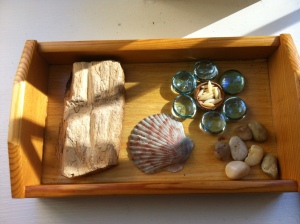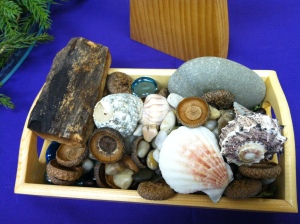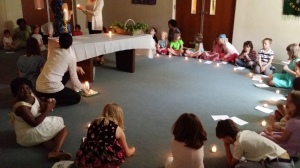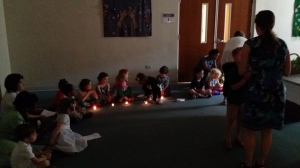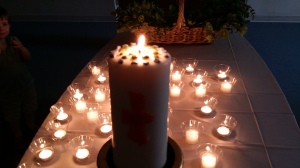My cat named herself “Margaret, Queen of Scotland.” Really.
Last year one little black and white cat attempted to adopt me by adorably rubbing up against her cage and mewing to be petted. Her name was “Spider” because she had been a great climber in her youth. I tried calling her “Spider,” but it just wasn’t working, so I thought I’d try other names. The Rev. Jonah Kendall had just been talking about Margaret of Cortona, so called to her, “Margaret of Cortona?” She paused, looked at me, then resumed her pacing as if to say, “Well, Margaret is okay, but not ‘Cortona’”. So I tried again. “Margaret, Queen of Scotland?” She paused longer this time, looked straight into my eyes as if to say, “Queen. Yes, that’s fine,” and then the audience was over. Of course, once a cat names herself in your presence, it’s awfully hard not to invite her to come and live with you. She has been the most wonderful addition to our family: joyful, regal, affectionate, demanding but cute…even the dog likes her. But don’t ask me where I got the name, it must have been the Holy Spirit.
And “Who was this Margaret Queen of Scotland?” you may ask…
Send your child to and/or volunteer June 16th-20th for our evening Vacation Bible School which will be focused on a few pilgrimages and the saints that inspired them (June 8th is the last day to register children).
As I was preparing for our upcoming VBS, I learned that one night will be focused on Queen Margaret’s life and on the pilgrimage to Dunfermline Abbey. Before, I really didn’t know anything about Queen Margaret other than her name. From what I have learned, my cat named herself well. The human Margaret grew up in exile, was able to return home (England) with her family in power, only to be exiled again, then lost at sea, then land in a strange place with strange people (as in unknown, not meaning weird) that she would come to love and rule. Sadly, more than once she had to grieve the loss of a child.
So, if you thought Margaret was just a fairy-tale princess, think again. She was famous not for her jewels and silks, or a happily-ever-after-life, but for her love of God. She is traditionally characterized as pious, intelligent, and educated. She was able to convert her husband and most of Scotland with her compassion and generosity (it is said that every day she personally invited the poor into the castle for dinner), her spiritual discipline and desire to improve worship, and her drive to found institutions and systems that improved life for all (establishing a hospital, a ferry, and an abbey, to name a few). When she wasn’t praying, taking care of her family, or saving the world, Margaret was also a renowned needle-worker who sewed cloths and garments for liturgical use.
Margaret is a saint because she used all of what God gave her: from her power and status, to her compassion and creativity, all of these gifts she used to “do justice, and to love kindness, and to walk humbly with [her] God.” (Micah 6:8) We are each born with different God-given gifts and different opportunities for service, and thus prepared for a unique purpose in the Kingdom of God. In that way, we are all saints (or at least Saints-in-training).
Saints aren’t superheroes, and some saints are parents, just like you and me. Another famous mom was Monnica of Hippo, or Monica, mother of Augustine (i.e. of Augustine’s “Confessions). She was the original “helicopter mom” following her heretical son from Africa to Italy, praying for his salvation . And if you have a spouse or family member who is an alcoholic, or just doesn’t “get your whole Christian thing,” then Monnica might be your gal, as her husband seemed to be what our post-modern society might call “complicated.” Jonah’s own favorite, Margaret of Cortona, was a single mother whose pre-conversion story reads like a Jerry Springer production of “Cinderella” . If you ever had low self-esteem, grieved a traumatic end to your first love, wondered if or finally realized that God really loves you, Margaret of Cortona might be for you.
Last Lent the oldest children in the Golden Thread/Level 3 atrium participated in an online game organized by the Episcopal Church to learn about saints called Lent Madness. Our church continues, and will continue, to add people to our calendar for commemoration, and these modern saints really open up the meaning of sainthood for the children. They loved learning that some saints had local connections to Raleigh (Anna Haywood Cooper), Durham (Pauli Murray), and even St. Philip’s (Thomas Gallaudet).
The more time I spend learning about and praying with the saints,the more they seem like friends.
My interest in saints began when I started to read the Morning Office for the daily scripture as a retreat discipline. Many days would include a “hagiography” or introduction of a saint on their feast day. I was intrigued by their miraculous yet human lives. They were real people who let the love of God transform them into extraordinary witnesses. Now that I am more familiar with the liturgical calendar, I have begun to look forward to my favorite saints’ feast days. Some are even on my Google calendar! Waking up, turning on the computer, and seeing the name of a favorite saint makes me smile. If I have time, I particularly focus on the collect written in honor of their feast day. The collect may be an entry into my own meditation, or it may close my prayers and be my entry into the rest of the day.
Sometimes when I pray, my spirit needs these saints as companions when God just seems to huge, remote, or divine-other. Sometimes I visualize them just as I would a spiritual director, friend, or counselor, asking them for advice and help. Other times one of their quotes will come to me just when I need it. What would Teresa of Avila do? Some of my other favorites are Peter, the Woman at the Well, Paul, Ignatius of Loyola, John Donne, Charles Wesley, Philips Brooks, Therese of Lisieux, Oscar Romero, and Thomas Merton, to name a few.
There are seemingly countless others too: men and women from all the ages and all over the world and from a variety of liturgical traditions and denominations. Episcopalians may want to start with James Kiefer’s hagiographies that are used for the morning office because there are currently a number of liturgical calendars in use, including Holy Women, Holy Men which has the most recent additions. You can look up saints by their name or you may want to search a particular day, like your birthday, and see who you discover. It may take some time before you find a saint who speaks to you, but there’s no wrong way to get started with the saints!


